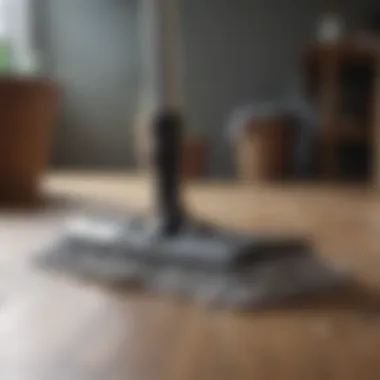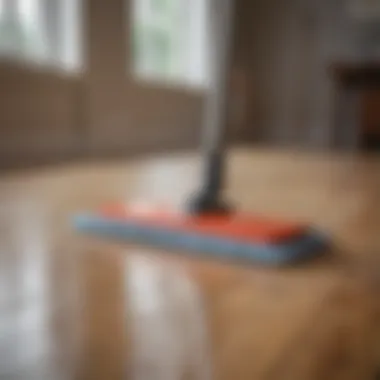Choosing the Ideal Mop for Floating Floorboards


Intro
Choosing the right mop for floating floorboards is essential for maintaining their beauty and longevity. Floating floorboards, which are designed to expand and contract, require specific cleaning tools to avoid damage. Many homeowners may not be aware that using the wrong mop could result in scratches, warping, or water damage.
In this guide, we will explore various mop types and materials that are well-suited for cleaning floating floors. We will address common challenges that come with maintaining these surfaces and provide best practices to ensure your flooring remains in excellent condition for years to come.
Exquisite Architectural Designs
Unique Home Features
Floating floorboards are often chosen for their aesthetic appeal and versatility. They can be found in modern and traditional homes alike. These floorboards are constructed as a tongue-and-groove system that permits them to 'float' above the subfloor without being attached directly. This unique design allows for easy installation and contributes to a sleek and seamless look in any room.
Historical Significance
The utilization of floating floorboards has historical roots, dating back to the early 20th century. They have evolved from simple designs to intricate patterns, offering homeowners a blend of practicality and elegance. This evolution reflects changing architectural trends and advancements in materials used for flooring. Understanding this historical context can enrich a homeowner's appreciation for their flooring choice.
Interior Decorating Tips
Color Schemes and Trends
When it comes to floating floorboards, the color of the flooring can significantly influence the overall aesthetic of a room. Darker shades can imbue a sense of richness, while lighter colors evoke brightness and space. Consider how the color of your mop can complement your flooring. Choosing the right shade for cleaning tools can enhance the overall look while ensuring they blend into your home decor.
Space Optimization Techniques
Maintaining the appearance of large open areas with floating floorboards requires careful consideration of cleaning techniques. Using a lightweight mop designed for such surfaces can help maneuver easily in tight spaces. Techniques that involve minimal water are ideal to prevent swelling or warping. Homeowners should focus on tools that combine efficiency and gentle care.
“The right cleaning tools not only preserve the integrity of your flooring but also enhance your home's overall aesthetic.”
In summary, selecting the best mop for your floating floorboards involves an understanding of both the unique characteristics of these floors and the best cleaning practices. As we delve deeper into specific mop types, materials, and techniques, you will be equipped with the necessary information to care for your flooring with confidence.
Understanding Floating Floorboards
Floating floorboards have gained popularity for their aesthetic appeal and practicality. Understanding them is crucial for effective maintenance, particularly when it comes to choosing the right cleaning tools. This section delves into the critical characteristics, benefits, and common materials involved in floating floorboards, helping readers make informed decisions.
Definition and Characteristics
Floating floorboards are designed to interlock and sit above a subfloor, creating a gap that allows for expansion and contraction. This construction method distinguishes them from traditional hardwood floors, which are nailed down. The primary characteristics of floating floors include their ease of installation, versatility in design, and the ability to mimic various materials like wood or stone. They are often constructed from layers of high-density fiberboard or plywood, topped with a decorative surface layer. This laminate finish not only enhances their physical appearance but also adds a layer of durability.
Benefits of Floating Floorboards
The benefits of floating floorboards are numerous and noteworthy. One significant advantage is their ability to absorb sounds, contributing to a quieter home environment. Additionally, they are resistant to moisture, making them a preferred option for areas susceptible to humidity, like kitchens and basements. Their installation process requires less time and labor, reducing overall costs. Furthermore, they are easy to clean and maintain, provided the proper techniques and tools are utilized. Overall, floating floorboards offer a combination of style and functionality that appeals to both homeowners and renters.
Common Materials Used
Several materials are used in the manufacture of floating floorboards, each with distinct properties. Common options include laminate, engineered hardwood, and luxury vinyl.
- Laminate is created from layers of synthetic materials. It is cost-effective and offers a diverse range of styles and patterns.
- Engineered hardwood features a veneer of real wood over a multi-layer core, providing an authentic look with enhanced stability.
- Luxury vinyl mimics wood or tile but promotes water resistance and durability.
Each material comes with its own set of cleaning requirements, which should be considered when selecting a mop or cleaning solution for floating floorboards.
Cleaning Challenges for Floating Floorboards
Cleaning floating floorboards requires a careful approach. These surfaces offer aesthetic appeal and durability, yet they are not immune to specific cleaning challenges. Understanding these challenges is essential for maintaining the beauty and longevity of the flooring. Proper cleaning minimizes wear and prevents lasting damage, while also preserving the overall look of the home. Recognizing how to address these challenges is vital for homeowners and those involved in interior design.
Understanding the Risks
Floating floorboards, while user-friendly, come with risks that can easily compromise their integrity. One significant concern is water exposure. If excess water seeps into the seams of the floorboards, it can cause swelling or warping. This risk emphasizes the importance of choosing the right cleaning method and tools.
Additionally, using abrasive cleaners or harsh chemicals can lead to surface scratches and dullness. Such products may degrade the protective finish on the boards over time. It is also essential to avoid excessive scrubbing, which can harm the surface. An informed selection of cleaning gear helps mitigate these risks and protects the investment in flooring.


Identifying Problem Areas
Identifying areas that are more prone to collecting dirt and grime is a key aspect of maintaining floating floorboards. High-traffic zones receive the most wear and tear, thus requiring more frequent cleaning. These areas often include hallways, living rooms, and kitchen spaces where spills are more likely to occur.
Under furniture is another hidden problem area. Dust and debris tend to accumulate in these spaces, potentially leading to long-term scratches or damage if not cleaned regularly. Other common locations that require special attention include corners and behind appliances. Regularly inspecting these zones and creating a cleaning schedule can significantly extend the lifespan of the floorboards.
"Regular maintenance and understanding the unique nature of floating floorboards is crucial for preserving their appeal and function."
To summarize, being aware of the specific cleaning challenges related to floating floorboards is essential. Addressing moisture risks and focusing on high-traffic areas supports the overall maintenance goals. The right cleaning tools and techniques will not only ensure cleanliness but also enhance the durability of these surfaces.
Criteria for Selecting the Best Mop
Choosing the right mop for floating floorboards is essential for proper maintenance. It helps to protect the flooring material and extend its lifespan. The criteria for selecting the best mop revolves around three primary aspects: material compatibility, design features, and ease of use and maintenance. These elements not only impact the cleaning results but also influence the overall experience of maintaining the floor. Understanding these criteria can lead to a more informed decision, ensuring that the selected mop aligns with the specific requirements of floating floorboards.
Material Compatibility
When selecting a mop, material compatibility is crucial. Floating floorboards can be made from various materials, including laminate, engineered wood, or luxury vinyl. Each type has its own cleaning requirements. For instance, using a mop that is too abrasive can cause scratches, while certain cleaning solutions can damage the flooring's finish.
A microfiber mop is often recommended due to its softness and efficacy. Microfiber can effectively trap dirt and dust without scratching the surface. Additionally, it can be used with minimal water, which is advantageous for materials sensitive to moisture. On the other hand, a traditional cotton mop may not be suitable as it tends to hold more water and could lead to moisture damage over time. Therefore, understanding the specific material of the floating floor is essential for choosing the right mop.
Design Features
Design features play a significant role in the functionality of a mop. Features such as the mop head's shape, size, and handle length can greatly influence ease of use. A mop with a swivel head allows for better maneuverability, enabling users to clean hard-to-reach areas without causing strain.
Furthermore, the weight of the mop should be a consideration. A lighter mop can be easier to handle, especially during extended cleaning sessions. Look for designs that allow for easy attachment and removal of cleaning pads. Some models come with velcro-style fasteners, making it simple to switch or clean the pads as needed.
"The right design can elevate the cleaning experience, reduce physical strain, and increase overall efficiency."
Ease of Use and Maintenance
Ease of use and maintenance is an important aspect when choosing a mop. A mop that is difficult to use or maintain can lead to frustration and discourage regular cleaning. Look for mops that are straightforward to assemble and disassemble. Tools that include washable pads are also beneficial, as this feature can save money and reduce waste compared to disposable options.
Regular cleaning of the mop itself should not be overlooked. If a mop is hard to clean or care for, it may not perform well over time. Simple designs with removable and washable components are preferable. Additionally, consider how the mop stores when not in use. Some models have compact designs that are easy to store, taking up minimal space.
In summary, by paying close attention to material compatibility, design features, and ease of use and maintenance, one can select a mop that not only cleans effectively but also complements the care routine for floating floorboards.
Types of Mops Suitable for Floating Floorboards
Understanding the types of mops suitable for floating floorboards is crucial for maintaining their appearance and longevity. Choosing the right mop involves consideration of materials and built design that aligns with the sensitivity of the flooring. Different mops offer varied cleaning techniques and functionalities which can either enhance or hinder the care of floating floors. Here are several mop types commonly recommended for such flooring.
Microfiber Mops
Microfiber mops are widely praised for their cleaning effectiveness, especially on floating floorboards. Their fine fibers attract dirt, dust, and debris without scratching the surface. This material provides a gentle yet thorough clean, making it suitable for regular maintenance.
- Benefits:
- High absorbency, which helps in reducing water exposure to the floor.
- Easy to wash and reuse, making it an eco-friendly option.
- Lightweight design encourages ease of use and flexibility.
Microfiber mops can be used dry for dusting or damp for deeper cleaning. Their versatility makes them a top choice among homeowners looking to maintain the aesthetic appeal of their floating floors.
Spray Mops
Spray mops offer a convenient option for quick cleaning tasks. They are equipped with a built-in spray mechanism that allows users to distribute cleaning solution evenly as they mop. This feature simplifies the cleaning process and reduces the time spent on maintaining floorboards.
- Considerations:
- Ideal for light cleaning. Not recommended for heavy-duty grime.
- Choose refillable cartridges to minimize waste;
- Look for mops with adjustable spray triggers for better control.
A spray mop provides a simple solution for maintaining cleanliness, especially in homes with busy lifestyles. Its design facilitates effective cleaning while minimizing excess moisture.


Steam Mops
Steam mops utilize heated water to sanitize and clean floors. The steam penetrates into grime and stubborn spots on floating floors, providing a deep clean without chemicals. This option is particularly beneficial for germ reduction.
- Advantages:
- Effectively removes allergens and bacteria.
- Typically, no harmful solutions are needed, which is safer for pets and children.
- Quick drying time minimizes the risk of water damage.
Steam mops are excellent for periodic deep cleaning. Proper usage is essential to avoid excessive moisture which may damage floating floors over time. Regular checks on steam settings can ensure a proper balance between cleanliness and safety.
Traditional Mops
Traditional mops remain a popular choice for various cleaning needs. They can be made from cotton, sponge, or other absorbent materials. While they may require more effort than modern alternatives, traditional mops can be effective when used correctly.
- Points to Remember:
- Opt for mops with soft materials to avoid scratching.
- Ensure thorough wringing out to minimize water exposure.
- Consider using a bucket with an appropriate cleaning solution.
Traditional mops can be a cost-effective option for those who prefer a hands-on approach to cleaning. With careful use, they can still serve well for light maintenance tasks.
To summarize, the best mop for floating floorboards depends on individual cleaning preferences and the specific requirements of the flooring. Each type of mop provides unique advantages that cater to different cleaning needs, allowing for a customizable cleaning strategy.
Top Mop Recommendations
In this section, we explore the best mops specifically suited for floating floorboards. Selecting the right mop is crucial because it influences both the cleaning efficiency and the longevity of your flooring. Each type of mop serves unique purposes, catering to various cleaning needs and preferences. By understanding the options available, homeowners can make informed decisions that safeguard their investment in floating floorboards while enhancing overall cleanliness.
Best Microfiber Mop for Floating Floors
Microfiber mops are highly recommended for floating floorboards due to their gentle cleaning action. These mops effectively trap dust and dirt without scratching the surface. A model like the O-Cedar EasyWring Microfiber Spin Mop is an excellent choice. It offers a functional design where you can wring excess water without bending over. This design promotes easier cleaning with less mess, which is particularly beneficial for maintaining the appearance of your floors.
Furthermore, microfiber pads are washable, providing a sustainable cleaning solution. This reduces the need for disposable products and is better for the environment. The absorbent nature of microfiber also means you can use less cleaning solution, making it cost-effective for regular use.
Best Spray Mop for Lightweight Cleaning
Spray mops provide convenience for quick clean-ups, ideal for busy households. The Bona Hardwood Floor Premium Spray Mop stands out as a top recommendation. It features a built-in spray that allows users to apply cleaner precisely where needed, eliminating oversaturation – a crucial consideration for floating floors.
This mop is lightweight and easy to maneuver, which simplifies the cleaning process. Additionally, it comes with a reusable microfiber cleaning pad, ensuring that your cleaning remains eco-friendly. The availability of refillable cleaning solutions is another bonus, allowing for flexibility in the types of cleaners you can use.
Best Steam Mop for Deep Cleaning
For periodic deep cleaning, steam mops are invaluable. The Shark Genius Hard Floor Steam Mop is a premier option. Steam cleaning effectively sanitizes without the need for harsh chemicals, making it suitable for households with children or pets. This mop generates hot steam that penetrates dirt and grime, providing a thorough clean.
One of the notable features is its dual-sided cleaning pads, which allow you to clean larger areas without frequent changes. This efficiency extends the cleaning process, making it quicker while ensuring the floor remains hygienic. However, take care to check the flooring’s compatibility with steam cleaning. Some floating floorboards may not tolerate the high temperatures well.
Best Traditional Mop for Versatile Use
The classic option, traditional mops, can still be effective. A reliable choice is the Libman Freedom Spray Mop. This mop combines traditional features with modern functionality, possessing a spray mechanism for quick use. It is sturdy and can tackle everything from daily spills to more demanding tasks.
If used with a proper cleaning solution, traditional mops can be a versatile tool suitable for different types of flooring, including hardwood and laminate. It also allows for disassembly, making it easier to clean and maintain. A significant advantage of this mop is its cost-effectiveness compared to newer technologies while still offering a substantial cleaning option.
Choosing the right mop is essential for maintaining your floating floorboards in optimal condition.
In summary, the right mop complements the unique requirements of floating floorboards. By choosing from microfiber, spray, steam, or traditional mops, you can ensure that your cleaning routines enhance the beauty and durability of your floors.
Maintenance Tips for Floating Floorboards
Maintaining floating floorboards is crucial for their longevity and aesthetic appeal. Floating floors require careful attention to cleaning and upkeep, as improper maintenance can lead to lasting damage. This section provides essential tips and techniques that ensure your floating floorboards remain in good condition. By following these guidelines, homeowners can enhance the durability of their flooring while preserving its attractive appearance.
Daily Cleaning Routines


Implementing a daily cleaning routine can significantly reduce the accumulation of dirt and debris on floating floorboards. Using a microfiber dust mop is an effective way to capture dust without scratching the surface. Here are some key steps for a daily cleaning routine:
- Sweep or Dust Mop: Use a microfiber mop to pick up surface dust and dirt. This is quick and avoids dirt buildup.
- Avoid Water Excess: If using a damp mop, ensure it is only slightly moist. Excess water can seep into the seams and cause swelling.
- Check for Particles: Inspect the floor for any particles or grit that might scratch the surface. Remove them promptly.
By adhering to these daily practices, you help in avoiding more intensive cleaning later and maintain the floor’s shine and integrity.
Periodic Deep Cleaning
Deep cleaning floating floorboards is essential but should not be performed too frequently. This process typically involves a more thorough approach to sanitizing the surface and eliminating stubborn stains. Recommended steps include:
- Choose Appropriate Cleaners: Use cleaners that are specifically designed for floating floors. Avoid harsh chemicals that can damage the finish.
- Wet Mop: Once every few weeks, use a damp mop with a suitable cleaning solution to clean the entire area. Work in small sections and follow with a dry mop to avoid moisture accumulation between seams.
- Inspect for Damage: During this process, check for signs of wear, such as scratches or dents. Address those areas immediately to prevent further issues.
Deep cleaning, when done correctly, helps maintain the floor’s luster and prevents the buildup of harmful grime.
Preventing Scratches and Damage
Protecting floating floorboards from scratches and damage is vital to their upkeep. Simple preventive measures can be taken that keep the floors looking their best:
- Use Furniture Protectors: Attach felt pads to the legs of furniture to alleviate pressure on the floor. This reduces the chance of scratches when items are moved.
- Avoid High Heels and Heavy Shoes: Encourage family members and guests to remove shoes with hard soles, as they can create indentations.
- Place Mats in Entryways: Use mats to trap dirt and moisture before it reaches the floor. This minimization of debris makes daily cleaning easier.
"Effective maintenance not only preserves the beauty of floating floorboards but also extends their lifespan."
By implementing these strategies, homeowners can maintain the allure of their floating floors while also ensuring their valuable investment is protected. Regular attention to maintenance will yield significant benefits over time.
Common Mistakes to Avoid
Cleaning floating floorboards can be tricky. Understanding common mistakes in maintaining them is essential for users. These errors may lead to damage of the floor. Avoiding such mistakes ensures longevity and aesthetic appeal of your flooring.
Using Incorrect Cleaning Solutions
Selecting the right cleaning solution is crucial for maintaining floating floorboards. Many homeowners may reach for regular household cleaners without knowing they may cause harm. Products containing ammonia or vinegar can strip the finish and damage the wood. Instead, opt for a gentle cleaner specifically designed for floating floorboards. Look for pH-balanced cleaners that are safe for laminate or engineered wood.
- Tip: Always check the label before use.
- Recommendation: Using a soft solution diluted in water may be ideal.
This consideration is simple but essential. Without proper cleaners, the surface can wear out quickly. It can also lead to water damage over time, which is difficult to reverse.
Neglecting Regular Maintenance
Regular maintenance is non-negotiable for floating floorboards. Many people underestimate how often they need to clean their floors. Failing to maintain a routine can lead to a build-up of dirt and debris. This not only impacts the appearance but also the integrity of the floorboards.
Establishing a cleaning schedule can help. Consider daily sweeping or vacuuming. Weekly damp mopping with the right cleaner will also help prevent build-up. Additionally, seasonal deep cleaning may be necessary. This can involve a more thorough wash or even professional cleaning if required.
- Key Points:
- Set a cleaning routine.
- Use appropriate tools for maintenance.
- Regular checks for scratches and damages.
By following these steps, homeowners can preserve the quality and look of their floating floors. Consistent maintenance is more effective than dealing with accumulated grime later.
Finale
Selecting the right mop for floating floorboards is crucial for their longevity and appearance. As outlined in this article, effective cleaning techniques and proper mop types contribute significantly to minimizing the risks associated with these unique flooring materials.
One key consideration is the compatibility of the mop material with the surface of the floating floorboards. Using mops designed with microfiber or non-abrasive features prevents scratching and damaging the finish. Additionally, as previously discussed, understanding the specific type of debris or stains encountered can inform the choice of mop type.
Benefits of a Suitable Mop
A well-chosen mop not only cleans but also enhances the flooring's aesthetic appeal. The right mop maintains not only cleanliness but also protects the floor from elements that may cause wear over time. A good cleaning practice can prolong the life of the floor, preserving the investment made in your home.
When deciding on a mop, consider factors such as ease of use, effectiveness in handling common stains, and how well it aligns with daily maintenance routines. A mop that is easy to handle and maintain can encourage more frequent cleaning, which is beneficial for the overall condition of the floors.
In summary, the maintenance of floating floorboards requires thoughtful selection of cleaning tools. Understanding the unique characteristics of these floors and the specific mops that suit them is essential. By following the guidelines presented, homeowners can choose the best mop for their floating floorboards, ensuring that both their cleaning and aesthetic needs are met.
"Choosing the right cleaning tools can significantly impact the longevity and appearance of your floors."
For more detailed information on cleaning techniques and tools for various flooring materials, you can refer to articles on Britannica or participate in discussions on platforms like Reddit.
Taking these considerations into account will not only enhance the cleanliness of your living space but also ensure that your floating floorboards remain a source of pride.















